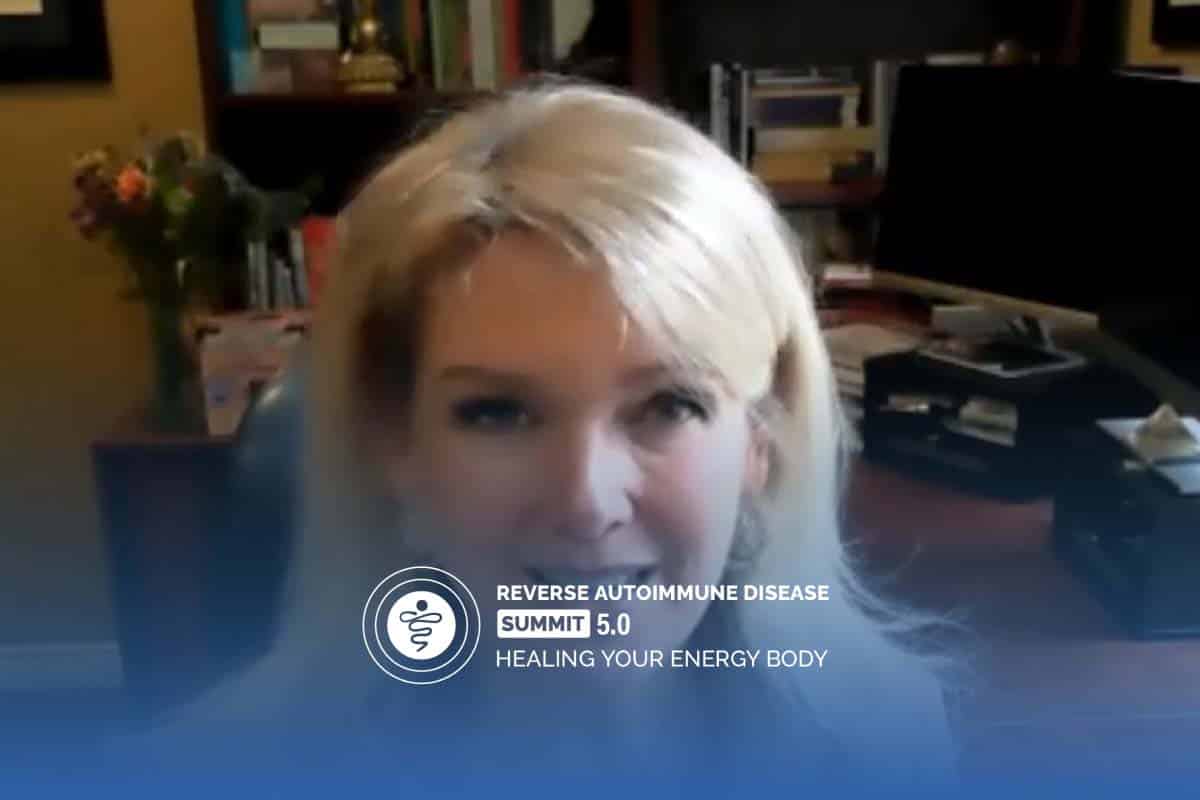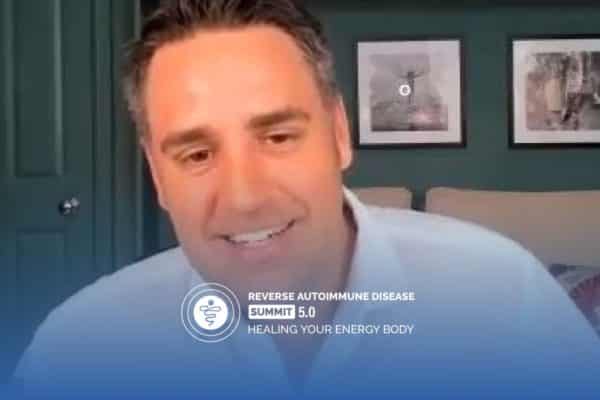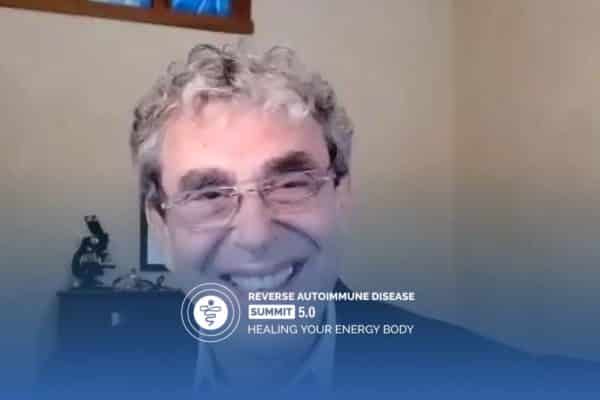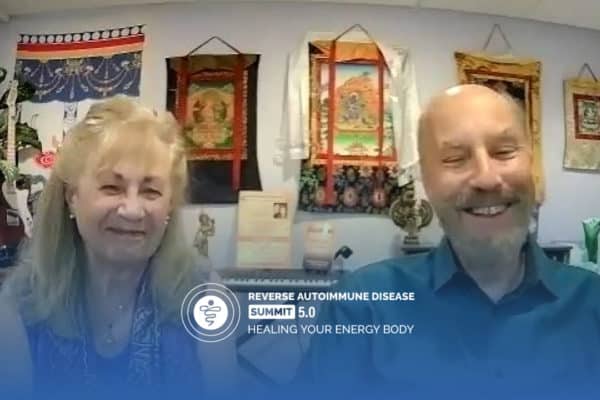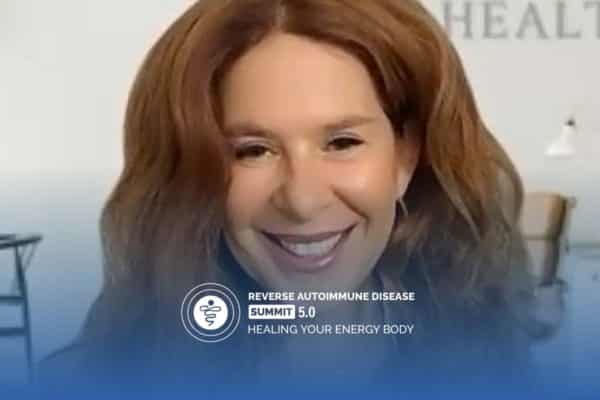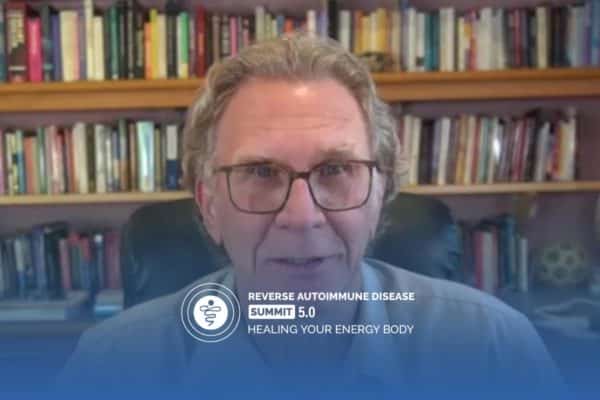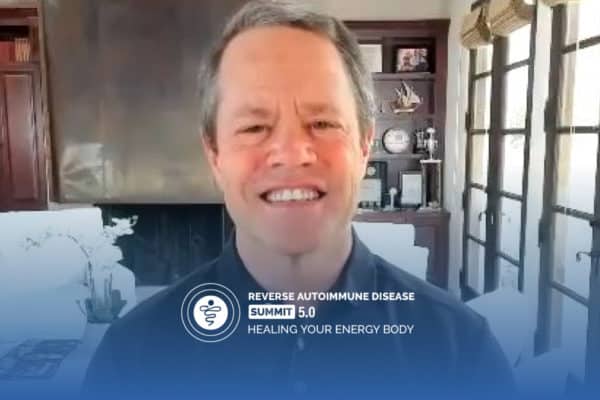Join the discussion below
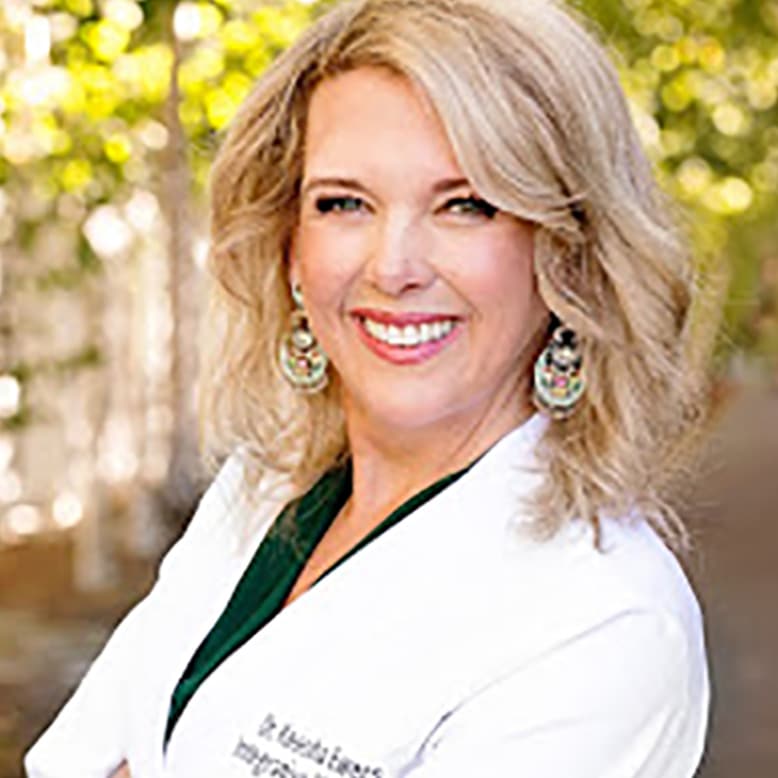
Keesha Ewers, PhD, ARNP-FNP-C, AAP, IFM-C
Dr. Keesha Ewers is an integrative medicine expert, Doctor of Sexology, Family Practice ARNP, Psychotherapist, herbalist, is board certified in functional medicine and Ayurvedic medicine, and is the founder and medical director of the Academy for Integrative Medicine Health Coach Certification Program. Dr. Keesha has been in the medical field... Read More
- Understand how the current healthcare crisis affects autoimmune diseases
- Learn to distinguish the different types of autoimmune diseases and their symptoms
- Uncover the role stress plays in certain illnesses
Keesha Ewers, PhD, ARNP-FNP-C, AAP, IFM-C
Welcome to the Reverse Auto-immune Disease Summit Series. I am Dr. Keesha Ewers this time, I thought, in this series, that I would put together, each day, a little webinar. I love to teach, so I thought- I would do this as a, kind of, a classroom setting, and we would, each day, approach each of what I call the four corners of the auto-immune puzzle, and give you some information that you can take away, right away, for reversing auto-immune disease. So I’m going to share my screen, and get the slide presentation going. Alright. So- these are things that I teach to my health-coaching students, at the Academy for Integrative Medicine.
So, as you- listen to this, in each one of these, at the end of them, I’m going to offer you a slot in that training program, if you’re interested, because I often get, after the Summit Series, emails that say, “I really want to work with you, how do I do that?” And there are, I mean, you know, I have- I work with people one-to-one, but sometimes, you are the person, because you’re the empath, and you’re the one that’s taking the reins in your family’s health, or your own, and people are asking you questions. So, sometimes, it’s the case that you’re, kind of, the smartest one in the room already, and that’s why you’re watching summits. I always say that I designed the Academy for Integrative Medicine for my patients, who- are so- much- more- educated, about some of these things, than a lot of doctors that I go to conferences with. So, it’s for the summit-junkie. So I thought at the end of this, I would offer- a scholarship.
If that’s you, a summit-junkie, who really wants to know how to individualize this, to your own- health- journey. So, everything that I talk about, in the next five days, are things that are gone into in a lot more depth, in my book, “Solving the Autoimmune Puzzle”, if you haven’t read it yet, and in its companion book, “The Quick & Easy Autoimmune Paleo Cookbook”. So, those two books have a lot more information than what I can offer, you know, in 40, 45-minute- webinars. But, I just wanted to, you know, give you that as a resource, in case you’re interested in diving a little bit deeper.
So if you don’t know who I am, my doctorate is not an MD, it’s a PhD. I’m a Nurse Practitioner, with a specialty in Integrative Medicine, I’m Board Certified in Functional Medicine, and Ayurvedic Medicine. My PhD is in sexology, I’m a certified psychotherapist, trauma-informed, five modalities for trauma-informed therapies, a certified Energy Worker, Yoga, meditation teacher, and Conscious Dying Doula, as well as a Masters of Divinity student, and I’m the founder of the Academy for Integrative Medicine Health-Coach Certification Program. What all of this says, is that I’m really curious.
I have a very curious mind, and my- mission is to really help people end their suffering. So my, my mantra, so to speak, is- having the opportunity, like Hippocrates said, “Healing is a matter of time, but it’s also sometimes a matter of opportunity”, that what the summits offer, for people, is an opportunity to get a lot of amazing information, that they can then individualize to their own- stories. So my story, if you haven’t heard it before, my apologies if you already have, is- that when I was short, shortly into my thirties, you know, just newly into my thirties, I was diagnosed with rheumatoid arthritis. It happened, as my patients always describe it, it felt like it was all of a sudden, but it wasn’t all of a sudden, it never is. It takes anywhere from 10 to 30 years to develop an auto-immune disease, so it definitely wasn’t all of a sudden. But, I had four little kids, I did things like run lots of marathons, and drove myself pretty hard, and- was a very high-energy person, and very driven. I always say there are four P’s in auto-immune disease, perfectionism and people-pleasing, and the poison of past pain.
And in the Ayurvedic paradigm, there’s a lot of Pitta in a person that has- auto-immunity, and those four things were definitely present for me. So, when I looked back at this woman, I think, “Oh man, she just, there was so much she didn’t know, and she was really driving herself into the ground, literally. So, one day I woke up, and it was like someone had taken the batteries out of the Energizer Bunny, which is what my friends used to call me, and I was just flattened. I had gained about 10 pounds of puffiness, all over my joints, was in a lot of pain, and just completely annihilated with- I was exhausted. I woke up, and I was- just exhausted. And so, I got in- I knew there was something really bad happening, and got in to see a physician, and I was asked if I had any family history of auto-immunity. And I said, “Yeah, I think my grandfather had rheumatoid arthritis”, which- I’ve circled him in this photo, that’s him. And, I was telling the story earlier this year, I turned 56, in February, and I realized that this man, my grandfather, died at the age of 56, with RA, and he was wheelchair-bound, for a number of years, with it.
So, you know that the things that we’re going to be talking about all week, in this Summit Series, all the things I’ve always talked about, the things that we get to dive into, and really, really absorb- that stuff wasn’t known, to this generation of people on the screen. So, my grandfather didn’t know any of the things we’re about to talk about, which is why at 56, I am healthier than I was- back here. A lot healthier, physically, emotionally, mentally and spiritually. So, you know, he didn’t have that opportunity to use RA as a call to action, as a way of saying, “Hmm, something I’m doing here is not working. What is it? Let’s investigate”. So, what happened for me, that day in the doctor’s office, is I was given two prescriptions, one for methotrexate, and another one, for a non-steroidal anti-inflammatory drug, and I was told, “Take these, and when you get worse,” not if you get worse- “come back, and we’ll, we’ll change your meds”. And that, unfortunately, 25 years later, is still was being said, and, I went home thinking, you know, I’d asked this- her, I said, “Is there anything else I can do? I’m really disciplined, you know, I mean, I run, I make my own food…” And she said, “No, I’m afraid that you have- you know, have drawn the short straw, in genetics, my dear”.
So, on my way home, I contemplated, I thought, “Yeah, it is genetic. My grandfather did have this, and he’s already dead, and is there, is there any way around that?” Back in those days, that wasn’t a conversation that was being had a lot, this thing called epigenetics. We didn’t really understand a lot about that. So, I had decided I was going to do some extra research, and I found- an article in Pubmed, where we keep our medical research, about- the usefulness of Yoga, and auto-immunity. So, I went to my first Yoga class, the next day, and that Yoga teacher said something about this word Ayurveda, which is the sister-science of Yoga, it’s 10,000 years old, it’s from India. And what this Yoga teacher said, as he was walking through, each of us holding our postures, was enough for me to go home, and look it up again.
I discovered that Ayurvedic medicine, all those thousands of years ago, thought about auto-immune disease, and cancer, as undigested anger. And I remember thinking about the idea, just the concept of digesting emotions, digesting feelings, and memories and experiences, as needful, the same way that I would digest an apple. I thought, “Ooh…”, and it was so new, and revolutionary. I was an ICU nurse in those days, we did not think this way . And so, I thought, “Okay!” So I started learning how to meditate, and eventually became a Yoga teacher, and, in that process of learning to become introspective, instead of driving myself like a crazy woman, I started thinking about the word auto-immune. It was dancing in front of my third eye one day, and I thought, “Oh, that means I’m killing myself, “auto” is me attacking me.
Is there anything I can do about that, because I really don’t want to die”. And then I thought, “When’s the first- time I wanted to die?” And that was really important, because then, I started following this little golden breadcrumb-trail, backwards in my memory, during that meditation, asking that question, why was I killing myself, and when was the first time I wanted to die? Because, I realized I was really kind of committing suicide, in a societally acceptable manner, and I didn’t want to die. Well, in that process, I discovered this 10-year-old little-girl version of myself, who was being sexually abused by the vice principal of her elementary school. And I just remember, like, my mind’s eye dropping on her, and seeing her, and just going, “Oh, she wanted to die”. She didn’t, she was so confused. She didn’t understand what was going on. She didn’t have the right words, obviously, to tell people what was happening, because nothing was helping. My dad was out to sea, I was a Navy brat, and anyone that I was talking to about it, I wasn’t saying the correct words to help them understand. I didn’t know the word sex, or molestation, or abuse, or any of those kinds of words, at that age.
And, so, it was a different era. and I was raised with no television, and so I don’t think I even had the vocabulary to say what was going on. So when I saw her, I thought “Oh, she did want to die, and this must have something to do with this current health-crisis I’m having”, and it turns out, science does tell us that that is true. So, through the next few webinars that I do, for this series, I’ll talk about ways of detoxifying. You know, the things that we think about, automatically are chemicals, or viruses or bacteria, you know, all of the things we think about as toxicants. But then, we’re also going to talk, a bit, about some of these things, like where are the undigested- parts of life, that are causing toxicity, in your your mental, emotional, and energetic bodies, which then keep you separate from your spiritual body. And I’ll show you a diagram of what I mean by that.
So, when I give talks to doctors, and, you know I work for the- I’m on the faculty of the Institute for Functional Medicine, and I give a lot of- of talks, to teach doctors to do what I do, and, I always say this, like, this is one of the primary reasons that people that are coming to see you aren’t getting better, is because every 8 minutes, in the United States, a child is assaulted, and that’s the only the reported ones. So these moments of whether it’s capital T Trauma, which is the kind of trauma we’re talking about, right this minute, sexual abuse, physical abuse, domestic violence, emotional, psychological, spiritual abuse, abandonment, neglect, all of these are what you could think of as capital T Traumas. And then the lowercase T traumas are the ones where we feel rejected or betrayed, and all of us have those. Every human, in childhood, has those experiences, those little T traumas, even if it’s not capital T, and it turns out the science says that it doesn’t matter if it’s capital T or lower-case t, it makes changes in your nervous system, reactivity pathways that impact everything.
And I’m going to explain all of that as we go. But, what I wanted to just start off with, is, you know, this is a picture of me as a little one, and I keep a picture, this very picture by my computer, all the time, because- if I do get triggered about something, and some toxic- response happens, i.e. cortisol floods my system, because I’m feeling unsafe, or unwanted, or invisible, or, you know, not heard, whatever it is, then I know it’s not my 56-year-old version feeling that, it’s this little one. And so I can connect to her, and I can say, “You know what? That’s not accurate, and I’m listening to you”. So there’s a lot that we can do, in attachment-trauma issues. And, you know, attachment theory tells us that, depending on our developmental state, when things occur, then we have attachment problems, and trauma. Hang on, just a second. It’s okay, yah.
My alarm just went off . And so, we can actually heal that. So, that’s over the years, what I’ve been able to do, and my rheumatoid arthritis was able to reverse, within six months. I never took those medications, because I dove in, and really started working on this level, immediately. And so, oftentimes, people will come to me, who have tried, tried everything, right? And, they haven’t been successful, because this part hasn’t been dealt with. So we’re going to talk, in this particular webinar, this talk, about auto-immune disease as today’s big healthcare-crisis. We wanna create a bridge between hope and despair, we wanna talk about the freedom-framework, which is how I reversed my own auto-immunity, and what I do with others, now. What the symptoms of auto-immunity are, in case you don’t know if you have an auto-immune disease.
The people that are listening to me, 10 to 30 years to develop one, then everyone’s just like, you know, it’s always said that everyone’s working on developing cancer? It’s same with auto-immune disease, whether or not it blossoms fully or not, that’s a standard American model of medicine, we have to have this diagnosis, right? But the way the Ayurvedic medicine thinks about it, is imbalances that are going deeper, deeper, deeper, because we haven’t figured out the root-cause, and fixed it. So that’s what the freedom-framework’s for. And then, we’ll talk about what types of illnesses are auto-immune, the role stress plays in illness, and that nervous system, that I was talking about.
So auto-immune, of course, means we’re attacking ourselves. Like, I figured out that day, in my early thirties. I’d tried learning to meditate, I was like, “Oh, this is me attacking me. There’s nothing to look for on the outside of me, it’s me”. And that was important, because there are things on the outside of us, but it, ultimately, if our bodies are attacking us, we have to really be cognizant of that, and say, okay, I want to really look at this. So, we know now, that there are over 50 million Americans, and I know it’s not just Americans watching this webinar, so my apologies for that, but worldwide, we have auto-immunity on the rise. There are over 140 auto-immune illnesses, now, rather than just 100. Many of them are illnesses that we already have names for, but we didn’t know they were auto-immune, like we used to call Type 1 diabetes the auto-immune version of diabetes, but now we know Type 2 is too, and Type 3.
And so, there’s, you know, people didn’t realize that Raynaud’s, or Restless Leg Syndrome, or psoriasis, or rosacea, eczema, all these skin issues, vitiligo- excuse me- could actually be auto-immune. Turns out it is. Our bodies, attacking ourselves. Now, women- have 80% of the auto-immune diseases. 80%. That is huge. Then some auto-immunity is more common in women than men, and more common in men than women. And so, this gives you a chart that looks at that. I found this fascinating, when I was first diagnosed, because I thought, “Well why do women get so much more auto-immunity?”, and that still is the question, in the literature. I have some theories about that. One is the way that, I think, our brains- that’s how I think, our brains are different than men’s. We have a different size of corpus callosum, and a different way of communicating, between our left and right brains. And I think because, in tribal days, we were responsible for keeping the toddlers out of the fire-pit, so they don’t get burned up, tanning the hides, grinding the corn, telling the stories, making sure we know what’s poisonous in the perimeter, and so the medicine, right?
Where the saber-toothed tiger den is, so that the children don’t get attacked. Like, we have so much information we had to hold, while the men were out hunting and gathering, that we became multi-taskers. And in that, needing to remember where the dangers are, I think we have Velcro brains. We remember our hurts, too, that’s why I say one of the four P’s of auto-immunity, is holding onto the poison of past pain. Like, if we’re hurt by something, we say, “Ooh, I’m not gonna forget that”, you know. But then, I’ll show you a way of tracking that, but that can, that can actually hurt us, even more . It’s good to remember the stove is hot, don’t touch the stove, but we can- we can take it a little far, further than just that. And then, the other piece around this, is we also have more estrogen-receptors than men, and we have so many estrogen-reproducing and mimicking chemicals, in our environment, these days.
And so we- have more fat-tissue on us, too, and, that’s where those lipophilic, or fat-happy, toxins like to live, in our fat. These wonderful breasts, that’s all they are, right? And so, and then we wear these great bras, I don’t wear a bra anymore, but that, you know, that cut off the lymphatic system, that then make it so that fat-tissue can’t drain the toxins. So then, we have this beautiful place that we just contain all of our toxins. So, there are several reasons, that women tend to have more auto-immune diseases, than men. We can actually do something about all of them, too. So, auto-immune diseases are the fourth-largest cause of disability among women, in the United States. It’s the second, most common chronic illness. Now, I think it’s actually first, now, because we have now started seeing that many… Heart-disease has always been number one in the US, for deaths, and chronicity.
But, the thing is, that we’re starting to say, “Oh, heart-disease is auto-immune too”. So, that means auto-immune disease is the biggest healthcare crisis, really in the world, in industrialized countries. So auto-immune illnesses are labeled and treated according to their target organ, rather than their root cause. So in other words, if you have Hashimoto’s thyroiditis, it’s all about the thyroid, in the way that the standard medical model, that the industrialized conventional medical model, thinks about it. Rheumatoid arthritis, we’re looking at joints, MS, we’re looking at nervous system, you know, so each… Rosacea, we’re looking here, lupus, we look multi-system, scleroderma, same, but we tend to think about the target tissue. And I think about that as, “Well, if we’re thinking bout the target tissue, and we’re just running around in the forest, moving this target, so the arrow can’t hit it, why aren’t we going to the archer, which is the immune system, who’s firing the arrows, and tap them on the shoulder, and say, “Hey can you stop firing arrows, please, at that target?” and have that as the conversation, rather than just talking about the target tissue.
Now, I gave a Hashimoto’s webinar, I give a webinar every month, about some form of auto-immune issue, and I did one on Hashimoto’s, last month, and what I was talking about, is the fact that- if you go to an endocrinologist, who happens to be- comprehensive, and holistic enough, to actually do auto-immune markers, with your thyroid check, and you find that it’s an auto-immune issue, rather than just a thyroid issue, they still will say to you, “Okay, well, let’s just keep an eye on it, until your thyroid is hypo-functioning, and then we’ll give you thyroid meds”. That’s it! That’s all they have! And that’s the way it is for all the auto-immune illnesses, you know, for RA, it was the same thing for me: “Rheumatoid arthritis? Take these two medications, and when you get worse, come back, we’ll start talking about immunomodulators”. That’s not okay, that’s why people are falling through the cracks.
So, we really want to build a bridge, from this old way of thinking about the target tissue only, into a new way, of really saying, “Okay, this is actually about the immune system, and what is aggravating it?” When I think about auto-immune disease nowadays, I think about- a bull, in a Spanish arena, and there’s a Matador there, he’s waving his red cape, and the bull is charging after it. You know, that angry bull, who is actually getting things shoved at him, to make him look more aggressive, is your immune system when you’re auto-immune. And we really want to make that bull, as your immune system, like Ferdinand the bull, in the flowers and the daisies, right, under the tree, who’s really peaceful. That’s what we would like. That has that strength to fight off an attacker, if needed, but sees everybody as kind, and compassionate, and friendly, until otherwise proven. That’s what we would like. So, when I tell you about bridging, I’m talking about, really, looking at how we’re perceiving. Okay. So brain, what that relay system is, which is hormones, what does the brain tell the body what to do next? Because that’s, who’s triggering your immune system. And then, what are your ideas about yourself, and your life?
Those are your meanings that you make up. We have to look at those, because those are the ones that are actually triggering your brain to say: “You’re not safe”. And some of those messages from the brain, that say that you, you know- that are the red cape in front of the bull, as your immune system, will be things that are dietary. Sometimes it’s microbial, in your gut, and sometimes, it’s about the way that you detox. And so, we’re looking at really bridging, right? We wanna make sure that we’re bridging yourself, from being in a combative relationship with yourself, to be a collaborator with yourself , being in a collaborative relationship, where you have compassionate curiosity with your body, and you’re asking it, “How can I support you? What do I need to do?” Instead of feeling like you’ve been betrayed by your body, and it’s not working, and it’s- needs to toe the line, and then we get frustrated, and angry, and that doesn’t make anything better.
So, each person is a puzzle, and there’s no one right way of doing this. I always tell people, there’s no such thing as an auto-immune paleo protocol, it doesn’t make any sense. Each person is different. So we, if we’re going to solve the puzzle, we wanna dump all those pieces of the puzzle out on the table, turn them all over, and then the first thing we do, is we look for the corner-pieces, and we want to anchor that puzzle. Then we’ll look for the edge-pieces, to make a frame, and then we’ll fill in the middle. But first we find the corners, and the corners for your puzzle, it doesn’t matter what is going on for you, we wanna look at those same four corners, and we have to kind of do it at the same time, because one of them is your genetics. Yeah, I had RA in my genes, for sure. One of them is environmental toxins, which this Summit Series is being devoted to. One of them is gut-health, and the other one is trauma, and how well you deal with your stress today, and what those nervous-system pathways do, in their reactivity.
Now, all of those things influence- how your genetics express themselves, which is why I was able to reverse my RA in six months, and not take meds, is because I somehow knew that right away, when I was asking the question, like: “How come I’m doing this to myself?”, and really got in there. People are always wanting to know, what is the thing that caused their problem? What is the one smoking gun? And there’s not any such thing as that. I call it critical mass. I would spend half-time on San Juan Island, and I have to ride a ferry to get over to the Island, and when they load the ferry up, they do so in a very methodical way, there are ferry-workers, who point to each car, and say where it needs to go. because they want to load it, with the understanding that it has to float. So if all the cars are on one side, then it’s going to tip. That’s actually how our bodies require us to work with them, too.
So, whenever we get triggered into an auto-immune flare, know that there has been a lot of stuff that’s stacked up on that scale, beforehand, and then that final thing tips it. It might be Epstein-Barr virus, that flares, because you had a crisis, and you got too tired. It might be a childbirth, it might be a huge job-stressor, or the loss of a loved one. It can be traveling, it can be moving into a new house, where there’s a ton of mold, but, know that if any of these things are true, and you got an auto-immune illness as a result of them, that it was because you were already primed for that. Then, that it was in your genetics too, and that this one last thing- capsized your boat. So, when we say that, then, that means we have to start looking at all of the things that were already on your scale, and start taking them off. ‘Cause it doesn’t- you can’t just remove the one thing that capsized you, you actually need to get a lot of lightness, in this other side, that got heavy.
So we think about genetics, we’re talking about single-nucleotide polymorphisms, that have to do with a number of different things in your body. Not just this gene equals RA, or MS, or diabetes, no. We’re talking about the genetics responsible for your detoxification pathways, for methylation, for your mood, for what kind of diet you’re supposed to be eating. That’s actually in your genetics. We wanna look at not just gut-permeability, but also mental permeability, because- if you don’t have good boundaries in your life, and I always say, you have to start with good boundaries with yourself first, then, with the others in your life, then you’re going to have leaky gut too, which causes leaky brain, and all the other things that occur as the result. Environmental toxins don’t just mean- mold, Epstein-Barr, Lyme, herpes, COVID, it’s not just those things, those chemicals, it’s also your thoughts, your beliefs, the meanings that you created when you were a child, that create lack of self-worth, perfectionism, people-pleasing, and all of that. You know, the trauma component can lead to a lack of self-nourishment.
So, all of these things create part of that critical mass, and we put them on the freedom-framework, so we’re talking about solving your puzzle, so after we get those four corner-pieces in place, where you understand that’s what we’re looking at, all of it kind of at the same time, because they all are interdependent and interrelated. Then, we start looking at the edge-pieces, of the freedom framework. So we wanna uncover, I call these the four C’s, so I’m kind of slippery around the first C, it’s uncover the root causes, confront the data, connect the dots, and then create the life that you want, with intention, and you can’t do one of them, without the others first. So, uncovering the root cause, means that we’re going to look your physicality, root causes, right? We wanna look at your mind, we wanna look at heart, your spirit, and in your story, about the places where you’ve had again, trauma.
And then, we want to confront the data, and so we do functional medicine, laboratory testing. We look at your weight, we look at your energy-level, your libido-level, your quality of sleep, and what is the data that we get from that? And then we want to connect the dots, between your lifestyle-choices, that you’re making, and that data. So, in other words, if your genetics say that you’re really, really, really gluten intolerant, which I am in my genetics, and I eat gluten anyway, then, I’m gonna connect the dots between oh, here’s why you have inflammation and pain, and why your your weight’s not very good, is because your diet is not matching your genetics, connect those dots. Okay. Same with beliefs, and behaviors, and mood, and within your relationships. In my doctoral research, which we’ll talk about in another webinar, I actually discovered that the number-one reason women have low libido, is from having unhealthy, unhappy, unsatisfying, unfulfilling relationships. Romantic partnerships, that they’re unhappy in.
It doesn’t mean anything’s wrong with the person they’re are coupled with, it might be because of their beliefs and behaviors, and meanings they created, and now they have a so-called nourishment-deficit, in that relationship, as their perceptions. And so then, that actually creates all kinds of illness. So, I have a Ted talk, called, “Have you heard from your Libido Lately?”, where I talk a lot about that. So, create your life with intention, is the last one. So you know how you get to see all these books about- creating a different mindset, and, and just, you know, think positive, the law of attraction, and manifestation, that’s all great. But if those other pieces haven’t been put into alignment with you first, then this stuff doesn’t stick, the create your life with intention.
So we really need to go in and, you know, look at what needs to be- reflected on, the mirror, we’re clearing that trauma. Self-confrontation is really important, forgiving, and then reframing, and then, you find that your happiness level goes up. So, you don’t do this first though. You can’t, and it’s not even appropriate to. It’s a step-wise process of digestion. Alright. So, unfortunately, what I’ve discovered, after 25 years in medicine, is that- actually over 35, 35 years. Oh wow, yeah, 30 years. Sorry, I tend to do my maths really fast, that’s a lot. I’ve discovered that a lot of times, people have to feel fairly miserable, to be motivated to make those shifts. They would really rather do a pill, even if it’s a supplement. So, this work that I’m talking about, is very much- engaged in integrating work, it’s not passive, you know, it’s not something, you just shift your mind, and then it’s all better.
I always say, you know, it doesn’t matter what the auto-immune illness is, ’cause I’ll get emails that say, “Do you have any, any experience with helping people with myasthenia gravis?” or “Do you have any experience helping somebody with graves, or rosacea or PANDAS?” You know, all of it is auto-immune, and so, the answer is always “Yes”, because we’re talking about a target, rather than what’s going on at the root, which is the same. Okay. Depending on your genetics is where the target goes. And so, symptoms of auto-immunity are really, can be anything, right? Because it depends on the target-tissue, that some of the more common ones, fatigue is right up there, and brain-fog, and hair-loss, and digestive problems, and, you know, low libido, and it means that vitality is sinking for you, so you’re gonna feel all these things, your weight might be off, you could have joint pain, rashes, muscle weakness, menstrual-cycle changes, if you’re a female. The most common organs affected by auto-immunity, are the skin, the joints, the hormonal systems, red blood-cells and blood-vessels, connective tissue and muscles.
And, it causes stress. Sometimes, you know, when people say: “Well, I don’t have any other stress in my life, except for what’s happening in my body right now”, and that’s, that’s accurate. It’s very stressful to have your body not functioning the way that we want it to. And so, when you think about it, we are wired to be like the zebra, where, where we run from the lioness, if there’s a lioness on our tail, and then, either one of our herd gets taken down, and then the pride comes and eats them. And then the zebra herd will just, with, even sometimes within- eyesight, or earshot, will stop, and start grazing again, because they know the pride is totally fine, now. They’ve been fed, and they’re not hungry, and then everyone can wander along, and graze. All of their organ-systems come back to homeostasis. Humans don’t do that very well. Robert Sapolsky did this really beautiful book, called “Why Zebras Don’t Get Ulcers”, and it’s because of what I just said, you know, they can return back, into that space of alignment, very quickly, where we have all of these different things, like telephones, and computers, and driving, and you know, like all the things that can make us…
We can instantly see things that can stress us out. So, I always think we live in a time, that’s- whose hallmark is one of overwhelm. And I always think about overwhelm as the gateway to perfectionism, you know, because if you’re overwhelmed, that means you’re overwhelmed because you’re maybe not doing things up to the level that you would want to do them. And that’s a sign of perfectionism. So then, we also have this past pain and hurt, okay, that we hold on to, and then the relationship dissatisfaction, that I was telling you about. So these are one of the reasons that women get 80% of the auto-immune illnesses. And then, is it hormones that you need? ‘Cause that’s often what I get, is someone coming in, looking for hormones. My alarm just went off, again. Instead of looking at the root of that, and saying, oh, it’s because I feel stressed, overwhelmed.
I have a really, I’m really unhappy in my relationship, right now. All of these things that are happening are causing my adrenals to be in overdrive, which, then, if your adrenals are in overdrive, your body says, ooh, we’re not surviving. Then all of the hormones that are responsible for you feeling good, and having libido, and reproducing, are going to be hijacked, by your fight, flight, freeze or faint system, your sympathetic nervous system, because survival wins over reproduction. So, then I always say, we, instead of really thinking first and foremost about, “Oh, I need to take bio-identical hormone-replacement therapy”. I really need to think about the hole in the bottom of my boat, thats why my hormones are off, in the first place. And they’re both appropriate, bio-identical hormone-replacement therapy, but also fixing the hole in the bottom of the boat, because we really want to know, like, is this 4F stress-response system going off all the time, internally, and for every five minutes that you are upset, in this sympathetic nervous system fight, flight, flight, fight, faint, or freeze, you know I call it the internal harm and alarm, for every five minutes, you’re in that state, it takes your body eight hours to recover. Five minutes? Eight hours.
When I learned that math, I said to my body, “I am so sorry, so much debt to you”. So that’s really how stress impacts your hormones. You know, we have this perceived threat, which, it’s up to our perceptions, and then we go into that fearful thinking, and then our adrenals hijack everything, from our ovaries, or our testes, and we’re off to the races. Now, what does this have to do with your immune system? Well, that cortisol that’s released from those adrenals, breaks down your gut-wall, and then, when you have a leaky gut, then bad bugs can move in, and you know, and then you’re you’re into that auto-immune issue. So, I always, say a hypervigilant mind, equals a hypervigilant immune system.
Instead, we want to be in the 4F life-support system, parasympathetic, right? Where we’re fed, we’re friendly, we’re fertile, and we’re fearless. We call it the rested and digest, or the feed and breed system. And in that space, we’re more willing to engage in self-care, and in self-nourishing and breath-work, and meditation, and a gratitude practice, and prayer, and contemplative work, being introspective. That’s the only way we can, is when we’re in that parasympathetic place. So, you need to find your why, right? What is the why that’s going to help me engage in self-care to that level? How am I going to change my auto-immune mindset? I have to figure out my why. So for me, it was being confronted with methotrexate, and I have four little kids at home, who are used to the Energizer Bunny as their mom, and I’m now debilitated, just really overnight, this is what it felt like, and so my, why was, I don’t want my kids to have to suffer, because of the things that are happening to me, right now. So, I really wanna get after it. And so I did, which meant a lot of trauma-work, and- learning how to kick my sugar-addiction, learn my genetics, learn what my diet was, that was supposed to be for me, learn what my toxins were, that I had on board, which I had, and, you know, really, really work all four corner-pieces of that puzzle, and, within six months, the auto-immunity was in remission.
So I always say, reversing auto-immune disease, doesn’t mean curing it, because I could get rheumatoid arthritis back, today. I could start working on it today, and probably have it back within weeks. Yeah. So, I don’t, I don’t do the up and down, everything that I learned back then that switched it, I stay with . I don’t eat gluten, I don’t eat sugar. You know, I make sure that I engage in self-care, and I do it according to my individual four corners of my puzzle, because what I do, is going to be different than what you need, and we really want to individualize all that. So, people always ask me, what’s your auto-immune protocol, right? What’s Dr. Ewers’s auto-immune illness protocol? And I always say, no, there’s no such thing. Instead, we wanna make sure that we test, don’t guess.
We wanna look at what are the meanings and the beliefs you created, when you were a kid, in response to your different experiences in life? And then, what sets your nervous system going? We don’t wanna just do like vagal nerve, ish, you know, like work at a vagal nerve-level, where we’re saying, “Oh let’s just do vagal nerve stimulation”. No, we wanna to learn what’s setting you off, in the first place, right? Then, sure, emotional freedom technique, vagal nerve-stimulation, these are all great for getting the tidal wave to come back again, so you can get your body back to homeostasis, but what I really like, is to get it so that you learn how not to go off, in the first place, and then your immune system can settle. So, this- drkeesha.com/aimhc, which is Academy for Integrative Medicine, hc, health coach, aim hc.
This link right here, that we’re doing during this summit only, okay, you get $3,000 off of the tuition, which is usually 8,997, so it puts it down to 5,997, or 5,000, even. So, take a look at that, and there are payment plans, so, if you want to do the health-coaching program with me, and learn all of this, and how to do it for yourself, on an individualized level, and then help others, then, I really want to make sure that you can do that. So, this is what we’re- what I’m going to have at the end of each of the talks, this week, and then I’m going to be giving you information, about how to detox on all of these levels, using that freedom-framework.
So until tomorrow, I hope that you’re really, really enjoying the series, and all of the remarkable people, that I have here, that are talking about their expertise. I mean, just really, really good talks. And so, think about, as you’re listening to them, think about the freedom-framework, and how that all applies for you, because at the end of the day it’s really important that we individualize everything to your system, your body, your life experiences. Alright. Until next time, be well, and I’ll see you tomorrow.
Downloads

